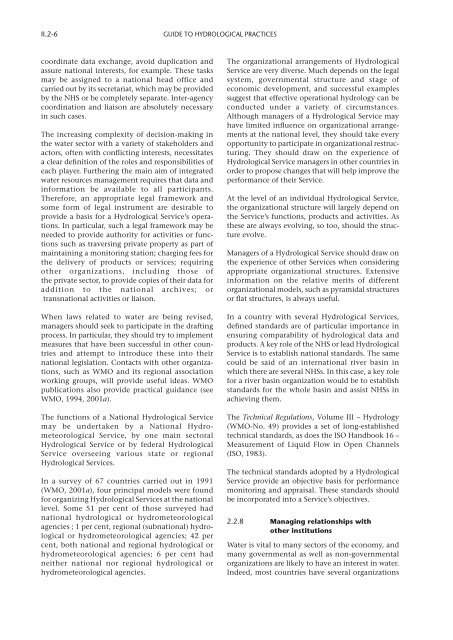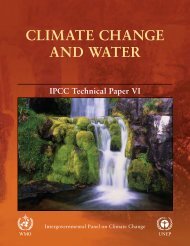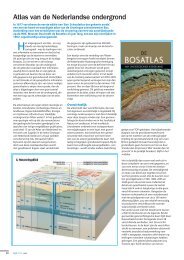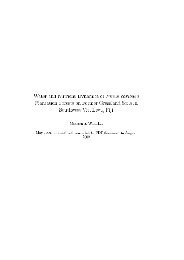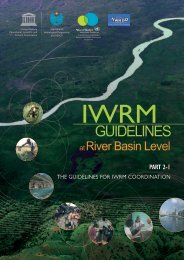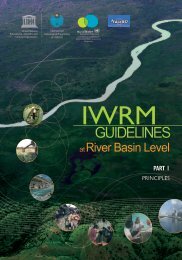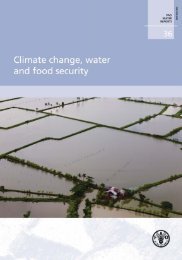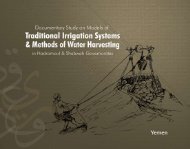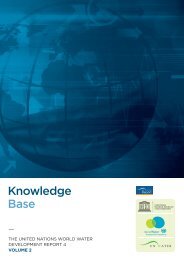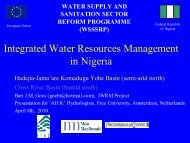Guide to Hydrological Practices, 6th edition, Volume II - Hydrology.nl
Guide to Hydrological Practices, 6th edition, Volume II - Hydrology.nl
Guide to Hydrological Practices, 6th edition, Volume II - Hydrology.nl
You also want an ePaper? Increase the reach of your titles
YUMPU automatically turns print PDFs into web optimized ePapers that Google loves.
<strong>II</strong>.2-6GUIDE TO HYDROLOGICAL PRACTICEScoordinate data exchange, avoid duplication andassure national interests, for example. These tasksmay be assigned <strong>to</strong> a national head office andcarried out by its secretariat, which may be providedby the NHS or be completely separate. Inter-agencycoordination and liaison are absolutely necessaryin such cases.The increasing complexity of decision-making inthe water sec<strong>to</strong>r with a variety of stakeholders andac<strong>to</strong>rs, often with conflicting interests, necessitatesa clear definition of the roles and responsibilities ofeach player. Furthering the main aim of integratedwater resources management requires that data andinformation be available <strong>to</strong> all participants.Therefore, an appropriate legal framework andsome form of legal instrument are desirable <strong>to</strong>provide a basis for a <strong>Hydrological</strong> Service’s operations.In particular, such a legal framework may beneeded <strong>to</strong> provide authority for activities or functionssuch as traversing private property as part ofmaintaining a moni<strong>to</strong>ring station; charging fees forthe delivery of products or services; requiringother organizations, including those ofthe private sec<strong>to</strong>r, <strong>to</strong> provide copies of their data foraddition <strong>to</strong> the national archives; ortransnational activities or liaison.When laws related <strong>to</strong> water are being revised,managers should seek <strong>to</strong> participate in the draftingprocess. In particular, they should try <strong>to</strong> implementmeasures that have been successful in other countriesand attempt <strong>to</strong> introduce these in<strong>to</strong> theirnational legislation. Contacts with other organizations,such as WMO and its regional associationworking groups, will provide useful ideas. WMOpublications also provide practical guidance (seeWMO, 1994, 2001a).The functions of a National <strong>Hydrological</strong> Servicemay be undertaken by a National HydrometeorologicalService, by one main sec<strong>to</strong>ral<strong>Hydrological</strong> Service or by federal <strong>Hydrological</strong>Service overseeing various state or regional<strong>Hydrological</strong> Services.In a survey of 67 countries carried out in 1991(WMO, 2001a), four principal models were foundfor organizing <strong>Hydrological</strong> Services at the nationallevel. Some 51 per cent of those surveyed hadnational hydrological or hydrometeorologicalagencies ; 1 per cent, regional (subnational) hydrologicalor hydrometeorological agencies; 42 percent, both national and regional hydrological orhydrometeorological agencies; 6 per cent hadneither national nor regional hydrological orhydrometeorological agencies.The organizational arrangements of <strong>Hydrological</strong>Service are very diverse. Much depends on the legalsystem, governmental structure and stage ofeconomic development, and successful examplessuggest that effective operational hydrology can beconducted under a variety of circumstances.Although managers of a <strong>Hydrological</strong> Service mayhave limited influence on organizational arrangementsat the national level, they should take everyopportunity <strong>to</strong> participate in organizational restructuring.They should draw on the experience of<strong>Hydrological</strong> Service managers in other countries inorder <strong>to</strong> propose changes that will help improve theperformance of their Service.At the level of an individual <strong>Hydrological</strong> Service,the organizational structure will largely depend onthe Service’s functions, products and activities. Asthese are always evolving, so <strong>to</strong>o, should the structureevolve.Managers of a <strong>Hydrological</strong> Service should draw onthe experience of other Services when consideringappropriate organizational structures. Extensiveinformation on the relative merits of differen<strong>to</strong>rganizational models, such as pyramidal structuresor flat structures, is always useful.In a country with several <strong>Hydrological</strong> Services,defined standards are of particular importance inensuring comparability of hydrological data andproducts. A key role of the NHS or lead <strong>Hydrological</strong>Service is <strong>to</strong> establish national standards. The samecould be said of an international river basin inwhich there are several NHSs. In this case, a key rolefor a river basin organization would be <strong>to</strong> establishstandards for the whole basin and assist NHSs inachieving them.The Technical Regulations, <strong>Volume</strong> <strong>II</strong>I – <strong>Hydrology</strong>(WMO-No. 49) provides a set of long-establishedtechnical standards, as does the ISO Handbook 16 –Measurement of Liquid Flow in Open Channels(ISO, 1983).The technical standards adopted by a <strong>Hydrological</strong>Service provide an objective basis for performancemoni<strong>to</strong>ring and appraisal. These standards shouldbe incorporated in<strong>to</strong> a Service’s objectives.2.2.8 Managing relationships withother institutionsWater is vital <strong>to</strong> many sec<strong>to</strong>rs of the economy, andmany governmental as well as non-governmentalorganizations are likely <strong>to</strong> have an interest in water.Indeed, most countries have several organizations


